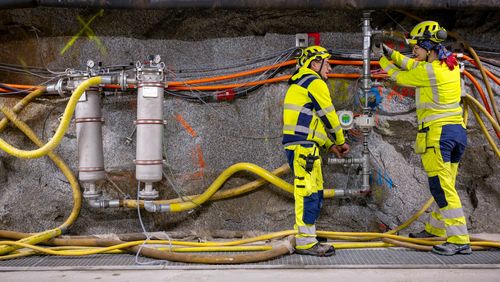
In the belly of the mountain
The Bedretto Underground Lab is located in a former ventilation arm of the Furka Tunnel—part of Switzerland’s Matterhorn-Gotthard railway line. The disused section of the tunnel is a little over five kilometres long, but not quite three metres in diameter, meaning that all research equipment—which was funded by the Werner Siemens Foundation—had to be squeezed through the narrow passageways. We talked to Marian Hertrich, geophysicist at ETH Zurich and manager of the Bedretto Underground Lab, about how he and the international research teams conduct their tests deep within the Saint Gotthard Massif.

The Bedretto Underground Lab officially opened in May of 2019, and the first tests were conducted shortly afterwards. What was your first project?
Marian Hertrich: We first had to determine what the “normal condition” of the tunnel is. We charted the tunnel walls to see what types of rock are located where, and what kinds of fissures—or joints, as we geologists call them—are already present. We measured the stress levels in the rock, and a specialised company made the large borehole for the stimulation treatments as well as the three boreholes for the measuring equipment. These preliminary experiments revealed key information about the elasticity and breakage patterns of the rock already before we began our actual work.
The Bedretto Lab is equipped with state-of-the-art instruments. How did you get them underground?
We used an electric construction trailer to transport eight truckloads of material into the tunnel: the drill casings, motors, pushrods, chains, packer systems, computers and more. It was a major logistic feat to fit everything into the narrow space.
The team began their work in August 2019, and the lab is located over two kilometres deep in the rock. Do the researchers always have to walk?
I like the walk, but the team can also ride in the electric construction trailer, although it creeps along at a snail’s pace.
How suitable is the Bedretto Underground Lab as a testing site for deep geothermal energy?
It’s well-suited, as the rock already has an ideal number of joints that we can drill through and use. At the same time, we also need enough unjointed rock areas for the stimulation treatments that generate new fissures—and the lab has plenty of these as well. We have a huge volume of rock to use for targeted stimulation treatments.
These stimulation treatments are of central importance in deep geothermal energy. Can you give a rough description of how they work?
We pump water at high pressure into the boreholes, which causes the granite to fracture into numerous joints. The conditions for the tests need to be as controlled as possible, meaning that the water shouldn’t fracture the rock until it’s at the end of the borehole. And because the rock breakage triggers movement below the ground, we also want to make sure that no perceptible—or worse: damaging—earth tremors are triggered.
How can you control these subterranean motions?
We use so-called packers to control the breakage. Packers are inflatable components, like balloons, on the long rods that we insert into the borehole. Then we inflate the packers a few millimetres until the borehole is hermetically sealed. There are 10 to 15 packers on each rod; that’s how we divide the borehole into separate sections. Afterwards, when water gets pumped into the borehole, only the sections between packers are subject to the pressure—and not the entire borehole. This makes it possible for us to systematically create joints in the hot rock areas, section by section, controlled and in exact doses. The volume of hot rock that the water runs through is called a reservoir.

Is there water in the reservoirs?
That depends on the kind of geothermal energy project. In the Bedretto Lab, the reservoir is made of jointed granite—it’s a hot dry reservoir that heats the pumped-in water. To generate electricity using the earth’s interior heat, deep geothermal energy power plants inject cold water into the hot reservoirs for heating. Then the heated water is brought to the surface and piped into turbines that generate electricity.
How deep is the borehole?
In our tests, we drill at a 45-degree angle, 300 metres into the granite. To make an ideal geothermal borehole, we would drill straight down, vertically, and then turn to make a horizontal borehole at the bottom. Unfortunately, we can’t do that here in the Bedretto Lab because the drill casing is 5 metres long, but the tunnel isn’t even three metres high. That’s why we have to quasi simulate the final part of an ideal borehole: the horizontal turn at the end.
What kind of rock are you drilling?
It’s Rotondo Granite, a very homogeneous granite mass with the same properties over several hundred metres.
Granite is, of course, hard. Is that a good or bad thing for your work?
Drilling into granite is expensive and more complicated than drilling into softer sedimentary rock, but it also demonstrates good breakage qualities.
Will you be able to apply the results of the tests with Rotondo Granite to regions with different geological properties?
No, but our experiments are highly relevant for other deep geothermal energy projects in Switzerland and in other regions such as Scandinavia. In northern Switzerland, there’s a lot of homogeneous granite several kilometres below the surface, and in Scandinavia, for instance, there are also large granite masses, so these regions will likely benefit from our findings. But deep geothermal energy projects in Munich or Vienna, for instance, are operating in limestone, which requires different procedures to transport heat from the rock up to the surface.
Who has made the most progress?
In regard to gaining a detailed understanding of the processes needed to make deep geothermal energy more efficient and also safer in the long term, Switzerland with the Bedretto Underground Lab and the Grimsel rock laboratory is definitely a contender.
Is there an independent authority that monitors the tests in the Bedretto Underground Lab?
Yes, impartial monitoring is very important in the project, and we invited the ETH Zurich Swiss Seismological Service to be on the team. The staff there follow our work closely and provide support in planning and conducting measurements. In addition, so that even the smallest earth tremors are registered, we installed three new seismographs in the general surroundings of the Bedretto Underground Lab: at the Furka, Nufenen and Gotthard passes. We also have seismographs in the tunnel’s interior: one at the entrance, one at the end, and three directly in the underground lab. These data are monitored by the Swiss Seismological Service and the findings are published online for the general public to read.
Text: Brigitt Blöchlinger
Photos: Felix Wey





